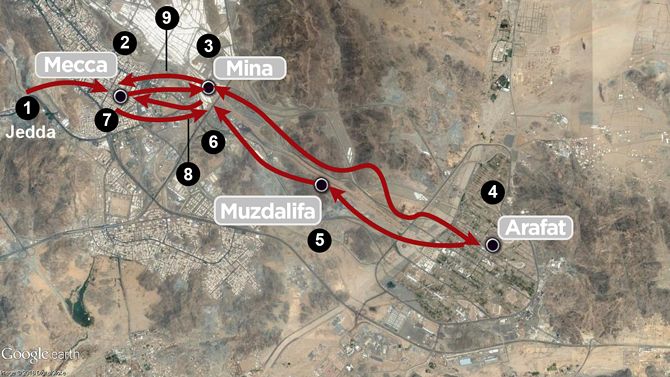What is the Hajj?
What is the Hajj?
Islam’s Hajj pilgrimage is one of the faith’s so-called five pillars and is a duty for all Muslims once in their lives if they are capable of it.
Each year, about two million Muslims from all over the world flock to Mecca in Saudi Arabia, Islam’s holiest city. Some save for a lifetime to be able to afford the journey.
Hajj begins during the 12th and final month of the Islamic lunar calendar, meaning that it can fall at different times in different years.
This once-in-a-lifetime obligation is an intense spiritual experience for any Muslim.
The Hajj culminates in the three-day Muslim festival of Eid al-Adha.

What are the rituals of the Hajj?
On each of the five days, pilgrims perform designated rituals with spiritual significance.
To carry them out, each participant must be in a state of Ihram, meaning ritual purity.
All rituals are important. Two of the best-known are:
- Circling the Kaaba (Tawaf): Pilgrims circle the black stone of the Kaaba in the centre of the Grand Mosque compound in Mecca. They do this seven times anti-clockwise at the start of the Hajj and also perform a farewell Tawaf as the last rite of the pilgrimage.
Prepping for the Haj—an annual Muslim pilgriamage to Mecca—is no mean feat https://t.co/s0m3hiWDuF pic.twitter.com/b8Gzqx8x6W
— The Economist (@TheEconomist) 7 septembre 2016
- Stoning of the Devil: Traditionally the most dangerous stage of the Hajj takes place outside Mecca, in the valley of Mina, where Muslims believe the devil appeared to the Prophet Abraham.
As pilgrims congregate around stone pillars symbolising the devil, deadly stampedes have taken place.
Saudi Arabia, where Islam first emerged around 1,400 years ago, has made efforts to ease congestion at stoning areas and improve safety generally.
But in 2015, hundreds died in a crush at the Hajj.
With interactive map, charts & Facebook photos from U.S. survivor, we explain how deadly 2015 hajj stampede unfolded https://t.co/OmISGznOIO
— New York Times World (@nytimesworld) 7 septembre 2016
Timeline of the tragedies of Hajj
The Haj has been marred by many disasters, including stampedes and tent fires, despite authorities investing heavily in better infrastructure.
In 2015, a crush of pilgrims travelling from the camp at Mina to the Jamarat bridge left hundreds dead.
Saudi authorities said 769 people were killed in the disaster, the highest Hajj death toll since a crush in 1990.
Counts of fatalities by countries who repatriated bodies showed that more than 2,000 people may have died, more than 400 of them Iranians.
Other tragedies over the decades at Hajj include:
December 1975 – A cooking gas cylinder explodes in the pilgrim tent city, causing a fire that kills over 200 pilgrims.
July 1987 – Iranian protesters clash with Saudi police, leading to the death of more than 400 Iranian pilgrims.
July 1990 – Inside the al-Muaissem tunnel near Mecca in Saudi Arabia, 1,426 pilgrims are crushed to death. The accident occurs on Eid al-Adha (The Feast of Sacrifice), Islam’s most important feast at the end of the Hajj and the day of the “stoning of the devil” ritual.
May 1994 – A stampede near Jamarat Bridge in Mina, near Mecca, kills 270 in the area where pilgrims ritually stone the devil.
April 1997 – 343 pilgrims are killed in a tent fire at the Hajj camp at Mina, prompting the government to construct a permanent, fireproof tent city there.
April 1998 – 119 Muslim pilgrims are crushed to death in Saudi Arabia at the Hajj.
February 2004 – A stampede kills 251 Muslim pilgrims in Saudi Arabia near the Jamarat Bridge during the stoning of the devil.
January 2006 – Some 362 Muslim pilgrims are crushed to death at the eastern entrance of the Jamarat Bridge during the stoning ritual.
September 2015 – A crane crashes into the Grand Mosque days before Hajj begins, crushing 111 people to death.











